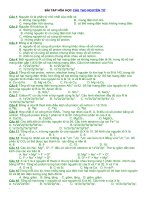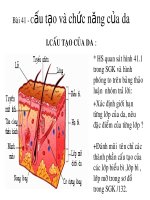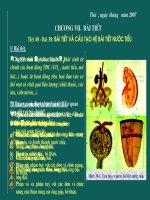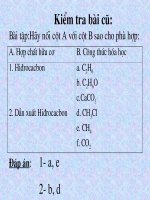Cau tao ADN
Bạn đang xem bản rút gọn của tài liệu. Xem và tải ngay bản đầy đủ của tài liệu tại đây (2.96 MB, 53 trang )
Chapter 27
Nucleosides,
Nucleotides,
and
Nucleic Acids I
Irene Lee
Case Western Reserve University
Cleveland, OH
©2004, Prentice Hall
Organic Chemistry
4
th
Edition
Paula Yurkanis Bruice
Nucleic Acids
In nucleic acid, the phosphate group is phosphodiester
The Bases in Nucleic Acids
Adenine, guanine, cytosine, and thymine are found in
DNA
Adenine, guanine, cytosine, and uracil are found in RNA
Nucleosides = Base + Sugar
Nucleotides = Base + Sugar +
Phosphate
Different Forms of Nucleotides
The energy released from ATP hydrolysis is used to drive
the phosphorylation of D-gluose (coupled reactions)
ATP as a Chemical Energy Source
Breakage of the Phosphoanhydride
Bond in ATP
Without ATP, the OH
–
group cannot be displaced
This reaction does not occur without ATP because of the
poor leaving group
Phosphoryl Transfer Reaction
Mechanism I
Phosphoryl Transfer Reaction
Mechanism II
Phosphoryl Transfer Mechanism III
P
O
-O
O-
O
P
O
O-
O-
+ H
2
O
P
O
-O
O-
OH
2
Pyrophosphate can be further hydrolyzed to phosphate
Why is the hydrolysis of a phosphoanhydride bond so
exergonic?
1. Greater electrostatic repulsion in ATP
2. More solvation in the products
3. Greater resonance stabilization in the products
P
O
-O
O-
O
P
O
O-
P
O
-O
O-
P
O
-O
O-
OH
+
The interactions between ATP, Mg
2+,
and arginine and
lysine residues at the active site of an enzyme
Since all the negative charges in ATP are neutralized,
ATP is readily approached by nucleophiles
Other Important Nucleotides
Cyclic AMP serves as a link between several hormones
and certain enzymes that regulate cellular function
The Nucleic Acids
Biosynthesis of DNA
occurs in the 5’ 3’
direction
Complementary Base Pairing in DNA
The sugar–phosphate is on the outside, and the bases
are on the inside
The DNA Double Helix









